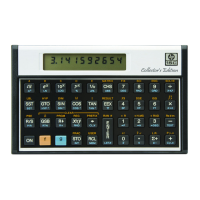202 Section 14: Numerical Integration
If the uncertainty of an approximation is larger than what you choose to
tolerate, you can decrease it by specifying a greater number of digits in
the display format and repeating the approximation.
*
Whenever you want to repeat an approximation, you don’t need to key the
limits of integration back into the X- and Y-registers. After an integral is
calculated, not only are the approximation and its uncertainty placed in
the X- and Y-registers, but in addition the upper limit of integration is
placed in the Z-register, and the lower limit is placed in the T-register. To
return the limits to the X- and Y-registers for calculating an integral again,
simply press ) ).
Example: For the integral in the expression for J
1
(1), you want an answer
accurate to four decimal places instead of only two.
Keystrokes Display
´ i 4
1.8826 -03
Set display format to i 4.
) )
3.1416 00
Roll down stack until upper
limit appears in X-register.
´ f 1
1.3825 00
Integral approximated in i 4.
®
1.7091 -05
Uncertainty of i 4
approximation.
The uncertainty indicates that this approximation is accurate to at least
four decimal places. Note that the uncertainty of the i 4
approximation is about one-hundredth as large as the uncertainty of the
i 2 approximation. In general, the uncertainty of any f
approximation decreases by about a factor of 10 for each additional digit
specified in the display format.
*
Provided that f(x) is still calculated accurately to the number of digits shown in the
display.

